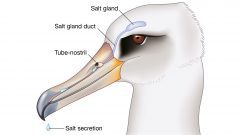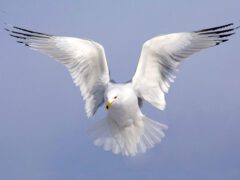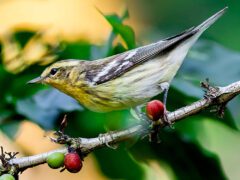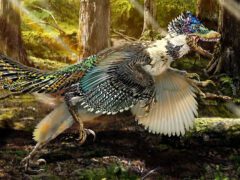Common Tern Similar Species Comparison
Main SpeciesCommon Tern
Breeding adult (hirundo/tibetana)
Medium-sized tern with deeply forked tail. Breeding adults have a gray belly, full black cap, and reddish bill. The upper side of the outer primaries is dark gray, creating a dark wingtip.
© Michiel Oversteegen / Macaulay LibraryAruba, July 28, 2019Breeding adult (hirundo/tibetana)
Medium-sized tern with a slender, straight bill. Tail is about the same length as the folded wings. Breeding adults usually have a grayish chest and bright red, black-tipped bill and red legs.
© Gale VerHague / Macaulay LibraryNew York, July 16, 2019Adult and juveniles
Breeding adults have a neat black cap and red bill with black tip. In this image, note the long crossed wingtips (above) about the same length as the forked tail (below). Nests in the open on beaches.
© Benjamin Clock / Macaulay LibraryMaine, July 18, 2012Nonbreeding adult (hirundo/tibetana)
Nonbreeding adults lose the front portion of their black cap, showing a white forehead and black hindcrown. Legs and bill turn blackish as winter progresses. Note tail does not extend beyond wingtips at rest.
© S. K. Jones / Macaulay LibraryFlorida, August 30, 2017Immature (hirundo/tibetana)
Immatures and nonbreeding adults have a distinctive black bar on the leading edge of the wing, known as a carpal bar. Tail does not extend beyond wingtips.
© Jody Wells / Macaulay LibraryBritish Columbia, September 25, 2017Juvenile (hirundo/tibetana)
Juveniles have a faint brownish wash to the back and a partial black cap that extends to the crown. They also have a dark leading edge to the wing, or carpal bar.
© Linda Ankerstjerne Olsen / Macaulay LibraryConnecticut, July 29, 2018Nonbreeding adult (hirundo/tibetana)
Flies with wingtips swept back with rowing wingbeats. Nonbreeding adults have a white forehead and black on the crown and behind the eye, with blackish bill. Note the black wedge on the upper side of the wingtips.
© Brendan Klick / Macaulay LibraryMichigan, September 09, 2017Breeding adult (hirundo/tibetana)
Medium-sized tern with deeply forked tail. Outer primaries form a dark wedge on the upper side of the wingtips. Wings are slender, swept back, and narrow at the base.
© Doug Hitchcox / Macaulay LibraryMaine, July 12, 2017Habitat
Occurs along shorelines, barrier islands, and estuaries, as well as on large inland lakes. In coastal areas, typically less numerous in brackish areas than along the ocean shore.
© Keith Lowe / Macaulay LibraryNova Scotia, July 13, 2017Similar SpeciesArctic Tern
Breeding adult
In flight, look for the paler gray wings on Arctic Terns compared to the darker gray wings on Common Terns. Also note that the underwing on Arctic Terns tends shows less black than Common Terns. Arctics also tend to hover more than common terns.
© Tom Johnson / Macaulay LibraryAlaska, June 08, 2015Similar SpeciesArctic Tern
Breeding adult
Arctic Terns are slightly smaller overall than Common Terns, with a shorter bill, shorter legs, and a rounder head with a steeper forehead—but distinguishing the two species takes practice.
© Brian Sullivan / Macaulay LibraryAlaska, May 20, 2012Similar SpeciesArctic Tern
Nonbreeding
Nonbreeding Arctic Terns are slightly smaller with shorter legs and bill than Common Terns. Nonbreeding Arctics have a grayer, less distinct (carpal) bar on the leading edge of the wing compared to Common's blackish carpal bar.
© Daniel Murphy / Macaulay LibraryCalifornia, August 20, 2016Similar SpeciesForster's Tern
Breeding adult
Forster's Terns have a slightly heavier bill that in the breeding season is orange rather than Common Tern's red bill. Breeding Forster's usually have a white breast, unlike Common Tern's gray breast.
© Steve Tucker / Macaulay LibraryCalifornia, May 06, 2017Similar SpeciesForster's Tern
Nonbreeding adult
Nonbreeding Forster's Terns can be separated from nonbreeding and immature Common Terns by the frosty-white wingtips on the upper side of the wing and the dark ear patch that does not extend onto the head like it does on Common Terns.
© Alex Lamoreaux / Macaulay LibraryFlorida, February 15, 2017Similar SpeciesForster's Tern
Juvenile
Juvenile Forster's Terns have more extensive reddish brown on the back and less black on the head than juvenile Common Terns.
© Ryan Schain / Macaulay LibraryMassachusetts, August 13, 2011Similar SpeciesRoseate Tern
Breeding adult
Roseate Terns are slimmer than Common Terns with a thinner bill and a longer tail. Breeding Roseate Terns are white or pinkish on the breast whereas breeding Common Terns have grayish underparts.
© Ian Davies / Macaulay LibraryMassachusetts, August 14, 2016Similar SpeciesRoseate Tern
Juvenile
Juvenile Roseate Terns have a scaled pattern on the back and lack the brown wash of juvenile Common Terns.
© Ian Davies / Macaulay LibraryMassachusetts, August 14, 2016Compare with Similar Species
Click on an image to compare
Species in This Family
Gulls, Terns, and Skimmers(Order: Charadriiformes, Family: Laridae)
More to Read
Don't miss a thing! Join our email list
The Cornell Lab will send you updates about birds,
birding, and opportunities to help bird conservation.









































